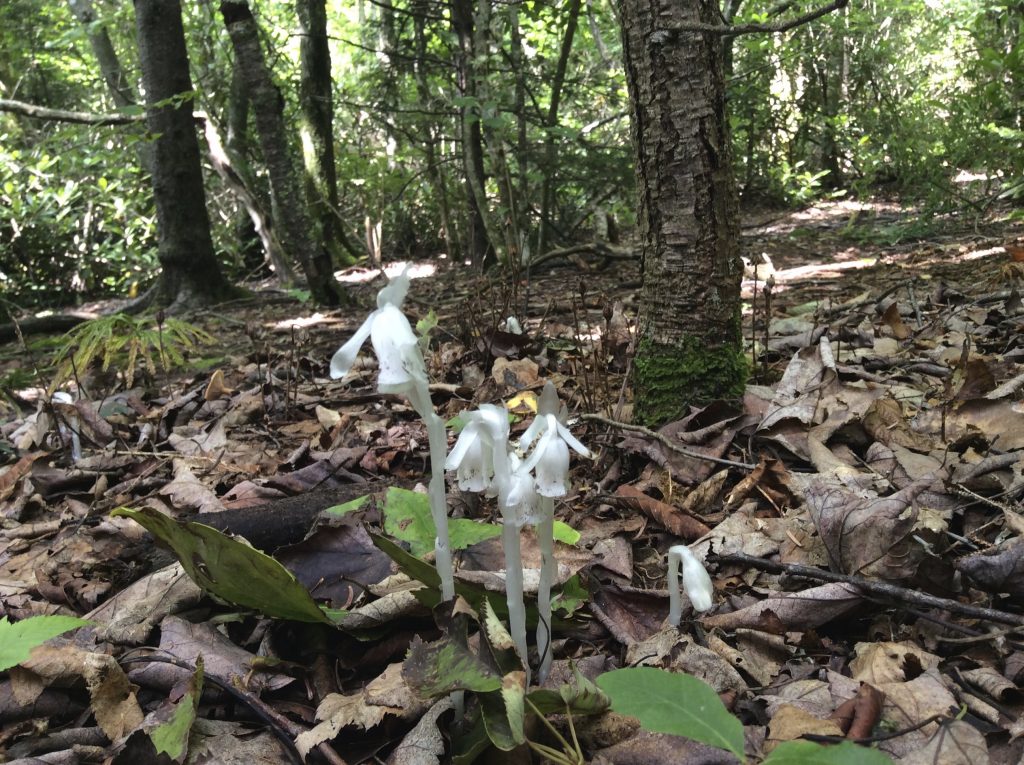
Ghost Pipes on Grandfather Mountain in North Carolina.
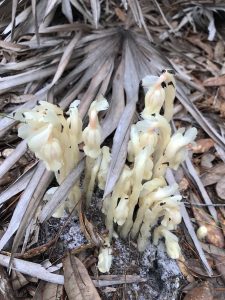
Ghost Pipes, Melbourne Florida. Photo by Green Deane
Time does not make a plant taste better. In 1904 one Walter Prest wrote that the Monotropa uniflora if parboiled, then boiled or roasted was comparable to asparagus. Merritt Fernald, who wrote a foraging book after WWI and was the big botanical man at Harvard from 1900 to 1950, gave them a try and said “Our own single experiment was not gratifying in its result.” Maybe Prest knew something we don’t. There is indeed an asparagus-like flavor to them but they are bitter. Maybe boiling twice would help. Pictures of them show up in profusion this time of year on mushroom pages for two reasons: This is their season and they are parasitic on several species of mushroom so mushroom hunters see them and wonder what they are. I wrote about them a decade ago. At the time they weren’t considered controversial. Now many people view them as special and needing protection. As the plants are quite bitter I’m not sure they need much protecting. You can read about them here.
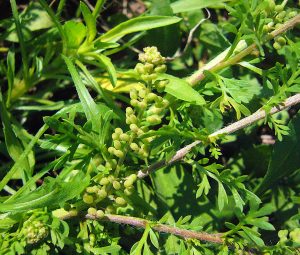
Swinecress is easy to identify. Photo by Green Deane
Swinecress is up, and Hairy Bitter Cress, too. They are little mustards one finds in the cooler weather. There are two interesting aspects to Swinecress. Once it has seeded it’s fairly easy to identify. Also Swinecress’ flavor intensifies after you eat it. It also has a naughty name. In fact, many plants have risque names ’cause the fellow who originally named them, Carl Linneas, either had a dirty mind or called them as he saw them. The species name, didymus, means a pair of testes and that is how the seed pod appears. Euphamistic writers try all kinds of ways to get around the obvious. It’s a good cooked green.
A 1944 study looked at some of the nutrients in C. didymus which at the time was also called C. pinnatifidus. They analyzed three samples. The protein content was 3.58 to 4.54%. Carbohydrates were low, 0.937 to 0.975%. Calcium was 0.081 to 0.181 grams per 100 gram sample, phosphorus 0.066 to 0.083 grams and sodium 0.014 to 0026 grams. Iron was 11.43 to 15.11 mg per 100 grams, high, copper 0.210 to 0.263 mg and manganese 0.583 to 0.875 mg. Curiously they tested the manganese not the magnesium. You can read about Swinecress here., and Hairy Bitter Cress here.
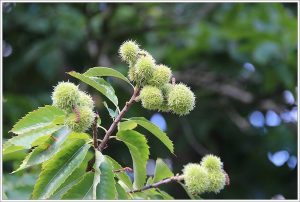
Chinquapins pack a lot of nutrition.
One way to think of Chinquapins is they are small Chestnuts that survived. In the same genus as their bigger relative — Castenea — when the blight wiped out the Chestnuts Chinquepins suffered but some managed to survive. One can see the Allegany Chinquepin (C. pumila) while hiking the Appalachian Trail. Their nut is about half of the size of their deceased relative but still worth collecting. We also know some of the nutrition of another edible Chinquepin, the Ozark Chinkapin (C. ozarkensis.)
Per 100 grams it has 443 calories, 18 grams of fat, 57 grams of carbohydrates, 13 grams of protein and 6 grams of fiber. The fat is 10 grams monounsaturated, 4 grams polyunsaturated and 4 grams saturated. Potassium is 77 mg, no sodium reported. A second report says they are 5% fat, 55 protein, 40% starch and 50% water with 4736 calories per kilo. European chestnuts, not affected by blight, are the only cultivated and consumed nut that has vitamin C, about 40 mg per 3.5 ounce serving.
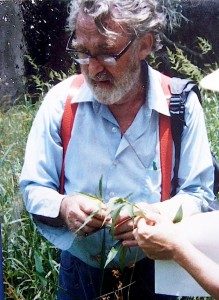
Dick Deuerling on a Native Plant Society dig when the Orlando Airport was expanding eastward in the mid-1990’s.
In the Beech family the Chinkapin has been called the most ignored and undervalued native North American nut tree. It has a sweet and edible nut and the tree has been used for fuel, charcoal, fence posts, railroad ties and a coffee and chocolate substitute (as are the seeds of the Blue Beech, aka the American Hornbean, Carpinus caroliniana.) Chinkapin’s native range is New Jersey and West Virginia, west to Missouri and Oklahoma, and south to Texas and Florida. It’s been planted in Wisconsin and Michigan. Dick Deuerling, who was Forager Emeritus locally until his death in July 2013, wrote there was a Chinkapin in Wekiva State Park but did not say where it was. One suspects where there is one there is two but I’ve not found them in the park.

Classes are held rain or shine (but not during hurricanes.)
Foraging Classes: Sticking to the east side of the state this weekend with classes in West Palm Beach and just south of Daytona Beach in Port Orange where we should see Goj berries blossoming and or fruiting.
Saturday November 27th, Dreher Park, 1200 Southern Blvd., West Palm Beach, 33405. 9 a.m. to noon. Meet just north of the science center.
Sunday November 28th, Spruce Creek Park, 6250 Ridgewood Ave. Port Orange, 32127. 9 a.m. to noon, meet at the pavilion.
Saturday December 4th, Bayshore Live Oak Park, Bayshore Drive. Port Charlotte. 9 a.m. to noon. Meet at the parking lot of Bayshore and Ganyard St.
Sunday December 5th, Mead Garden: 1500 S. Denning Dr., Winter Park, FL 32789. 9 a.m. to noon. Meet at the bathrooms. The park entrance is on South Denning. Some GPS directions get it wrong.
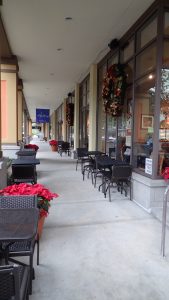
Panera’s in Winter Park where we start and finish the Urban Crawl.
My annual Urban Crawl is coming up, my twelfth, on Friday, December 17th. A reasonable question is what about foraging in a city? There is some surprising research. Dan Brabaner is a geoscience professor at Wellesley College, Boston. With some undergraduate students they studied preserved food collected from fruit trees and the like in the urban Boston area. What they found was cherries, apples, peaches and herbs were relatively low in lead and arsenic. That is, a serving had less amounts of these toxins than the allowed daily amount for a child. The team also did not find a significant difference between peeled and unpeeled fruit. The fruit was low in toxic chemical because they are the furthest away from any toxins in the soil. This would apply to tree nuts as well. Leafy greens faired well, too, because they grow fast and 1) don’t have time to accumulate toxins and 2) most air pollution on them can be washed off. Brabander also analyzed foraged food from plants growing in the urban environment not growing on agricultural soil. These foods had higher micronutrients because they were not growing on worn-out agricultural soil. Calcium and iron were higher as were manganese, zinc, magnesium and potassium. Thus we know that not only do “weeds” pack more of a nutritional punch because they are wild but also because they can be growing in better soil. My Urban Crawl is a free class. We meet in front of Panera’s at 10 a.m. in Winter Park. We wander south to the college, stop at Starbucks for a restroom break, go east to the public library area, then back to Panera’s. There is a free parking garage behind (west) of Paneras if you go to the upper floors. If you park on the city streets you chance a ticket as the class is longer than parking hours allow.

Green Deane videos are now available on a USB.
My nine-DVD set of 135 videos has been phased out and replaced by a 150-video USB. The USB videos are the same videos I have on You Tube. Some people like to have their own copy. The USB videos have to be copied to your computer to play. If you want to order the USB go to the DVD/USB order button on the top right of this page or click here. That will take you to an order form. I’d like to thank all of you who ordered the DVD set over the years which required me to burn over 5,000 DVDs individually.

Green Deane Forum
Want to identify a plant? Perhaps you’re looking for a foraging reference? You might have a UFO, an Unidentified Flowering Object, you want identified. On the Green Deane Forum we — including Green Deane and others from around the world — chat about foraging all year. And it’s not just about warm-weather plants or just North American flora. Many nations share common weeds so there’s a lot to talk about, such as the one to the left. There’s also more than weeds. The reference section has information for foraging around the world. There are also articles on food preservation, and forgotten skills from making bows to fermenting food. Recent topics include: California Wild Mushroom Parties, A Good Reason To Eat Wild Garlic, Black Walnuts and Amaranth, Sea Salt and Plastic, Wild Mustard? Heavy Metals. Oriental Persimmons. What is it? Pine Cough Drops and Needles, Skullcap, Malodorous Plant? Another NJ Tree, Maypop? Roadside Plant, Unknown in Sudan, Please Help Identify, and Preserving Prickly Pear Bounty. You can join the forum by clicking on the button on the upper right hand side of this page.
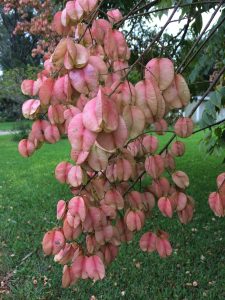
Easy to identify, difficult to remember, the Golden Rain Tree. Photo by Green Deane
The tree is easy to find but is it edible? The answer is yes, maybe, barely. It depends on which part you’re referring to. The problem is the more edible parts are around when you don’t notice the tree — spring time — and the least edible parts are around when you do notice it. Thus I never quite get around to knowing all that the Golden Rain tree has to offer. In the spring it has tender young shoots and leaves. They are edible after cooking. Don’t try them raw, they have a bit of cyanide in them. Months later in the fall the seeds are reported as a famine food, not exactly a glowing endorsement. In between the yellow flowers are used for a dye as is the bark. Those boiled leaves and shoots do have some antioxidant and anti-tumor capacity but the research is slow making it way out of arcane journals to common knolwedge. As for the seeds… they are kind of in the same position as the particular mustard seed which is used to make Canola Oil. They are edible but like unrefined Canola Oil they can be irritating. What I might try to do is collect some seeds, sprout them, boil them, and give them a try… but let me do that first instead of you. You can read about the Golden Rain Tree here.
his is my weekly newsletter #483. If you want to subscribe to this free newsletter you can find the sign-up form in the menu at the top of the page.
To donate to the Green Deane Newsletter click here.


Hey man, just wanted to say I’ve been following for a couple of years and really appreciate your consistency and look forward to coming to your meetups. Currently put together somethings to soldify a home base in Florida. Thanks brother and keep up the great work! Your changing the world, one plant and person at a time 😉